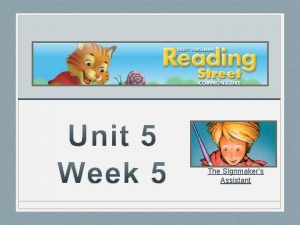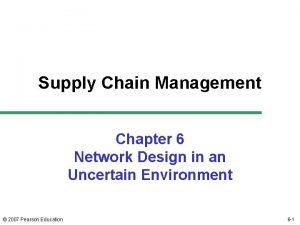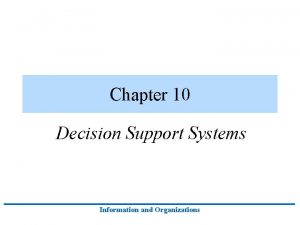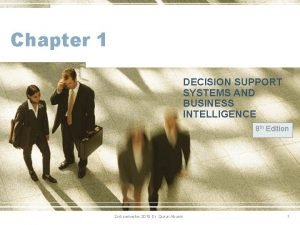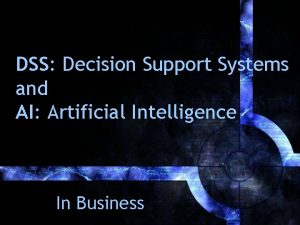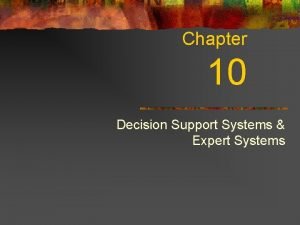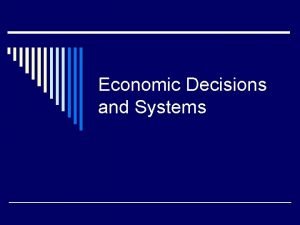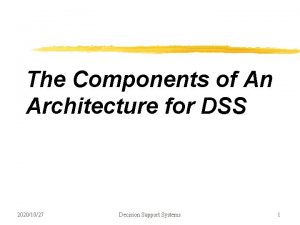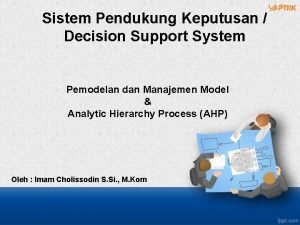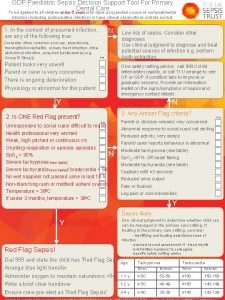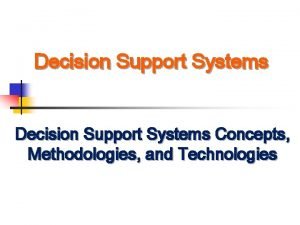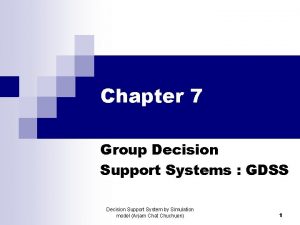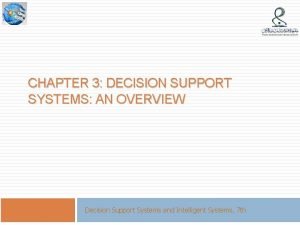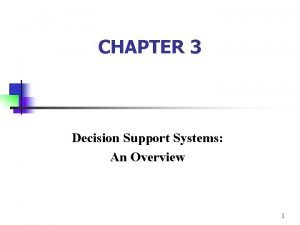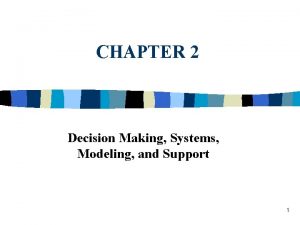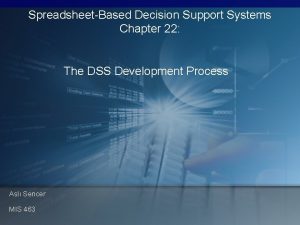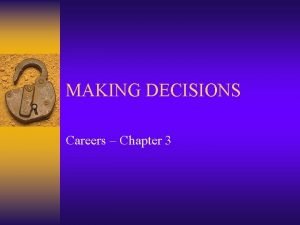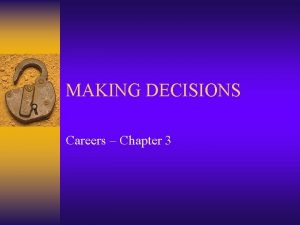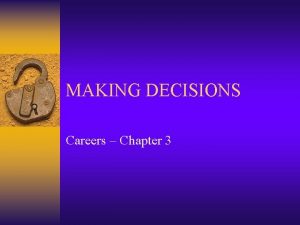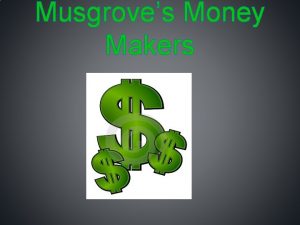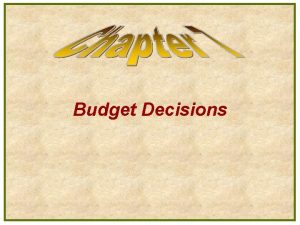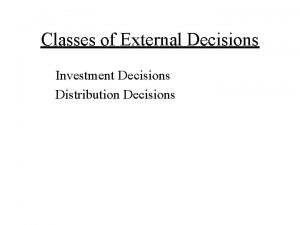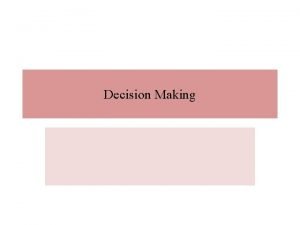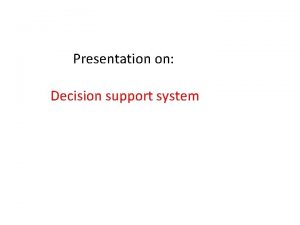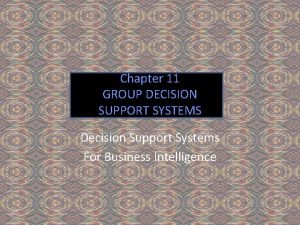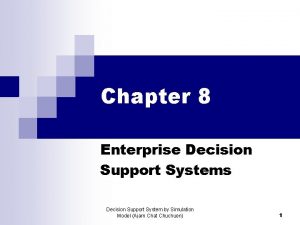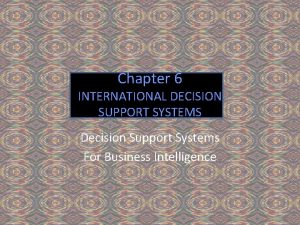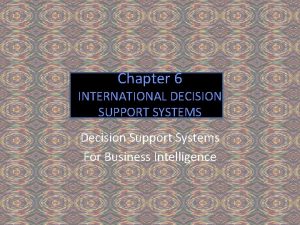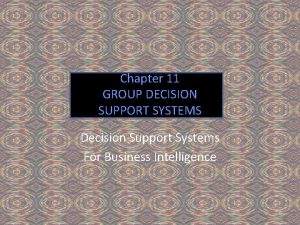Chapter 2 Decisions and Decision Makers Decision Support









































- Slides: 41

Chapter 2: Decisions and Decision Makers Decision Support Systems in the 21 st Century, 2 nd Edition by George M. Marakas: Decision Support Systems, 2 nd Edition © 2003, Prentice -Hall Chapter 2 - 1

2 -1: Decision Makers: Who Are They? Before focusing on the decision maker, we need a working model of what he is trying to accomplish. Figure 2 -1 (next slide) shows one of several ways to view the process. The decision maker plays a schizophrenic role since he is considered both a step in the process and also a participant. Marakas: Decision Support Systems, 2 nd Edition © 2003, Prentice-Hall 2

Example of a Decision-Making Process Marakas: Decision Support Systems, 2 nd Edition © 2003, Prentice-Hall 3

Classes of Decision Makers Many different types of DSSs exist because there are many different types of decision makers. Marakas: Decision Support Systems, 2 nd Edition © 2003, Prentice-Hall 4

Decision Maker Classifications Individual decision makers can be a single person or a computer system. Multiple decision makers can be: l groups where all members have a say in the decisions, l teams where members support a single decision maker, or l organizational where global agreement is needed. Marakas: Decision Support Systems, 2 nd Edition © 2003, Prentice-Hall 5

Classification of Decision Structures Marakas: Decision Support Systems, 2 nd Edition © 2003, Prentice-Hall 6

2 -2: Decision Styles Style is the manner in which a manager makes decisions. The effect of a particular style depends on problem context, perceptions of the decision maker, and his own set of values. The complexity of these intertwine in the formation of decision style. The basic classes of styles are illustrated on the next slide. Marakas: Decision Support Systems, 2 nd Edition © 2003, Prentice-Hall 7

Decision Style Model Marakas: Decision Support Systems, 2 nd Edition © 2003, Prentice-Hall 8

Decision Style Categories Directive – combines a high need for problem structure with a low tolerance for ambiguity. Often these are decisions of a technical nature that require little information. Analytical – greater tolerance for ambiguity and tends to need more information. Conceptual – high tolerance for ambiguity but tends to be more a “people person”. Behavioral – requires low amount of data and demonstrates relatively short-range vision. Is conflict-averse and relies on consensus. Marakas: Decision Support Systems, 2 nd Edition © 2003, Prentice-Hall 9

Decision Style in DSS Design Key issues are the decision maker’s reaction to stress and the method in which problems are usually solved. For example, to best serve a directive type who does not handle stress well, the interface needs to allow the decision maker to control the system without tedious input. For an analytic type, the DSS needs to allow access to many data sources which the decision maker will analyze. Marakas: Decision Support Systems, 2 nd Edition © 2003, Prentice-Hall 10

2 -3: Decision Effectiveness A good decision results in attainment of the objective within the constraints imposed. Most decision models suggest that the decision maker must balance the forces acting upon the process and contend with the dynamics of them. These forces can be of a several natures: Personal Emotional Economic Contextual Emergent Organizational Marakas: Decision Support Systems, 2 nd Edition © 2003, Prentice-Hall 11

Forces Acting Upon A Decision Maker Marakas: Decision Support Systems, 2 nd Edition © 2003, Prentice-Hall 12

2 -4: How Can a DSS Help? Some common types of support provided by a DSS: Explores multiple perspectives of a decision Generates multiple and higher quality alternatives Explores multiple strategies Facilitates brainstorming Provides guidance and reduction of bias Increases ability to tackle complex problems Improves response time Discourages premature decision-making Provides control over multiple sources of data Marakas: Decision Support Systems, 2 nd Edition © 2003, Prentice-Hall 13

2 -5: Why are Decisions So Hard? The four key areas that determine the relative difficulty of a decision are: 1. Structure – in general, the more structure, the less information required 2. Cognitive limitations – the human mind is limited to handling 5 to 9 distinct pieces of information Marakas: Decision Support Systems, 2 nd Edition © 2003, Prentice-Hall 14

2 -5: Why are Decisions So Hard? (cont. ) The four key areas that determine the relative difficulty of a decision are: 3. Uncertainty – the amount is based on how complete and accurate the information is 4. Alternatives and multiple objectives – the selection of one alternative may impede the progress towards a different goal Marakas: Decision Support Systems, 2 nd Edition © 2003, Prentice-Hall 15

Continuum of Decision Structures Marakas: Decision Support Systems, 2 nd Edition © 2003, Prentice-Hall 16

2 -6: A Typology of Decisions No two decisions are alike, but they can be categorized: Negotiation-based decisions can be classified as routine, creative, or negotiated. Activity-based decisions can be typed as entrepreneurial, adaptive, or planning. Strategy-based decisions can be grouped into computational, judgmental, inspirational, or compromise. Marakas: Decision Support Systems, 2 nd Edition © 2003, Prentice-Hall 17

Typology of Decisions Marakas: Decision Support Systems, 2 nd Edition © 2003, Prentice-Hall 18

2 -7: Decision Theory and Simon’s Model Keen and Scott Morton categorized decision theory into five perspectives. 1. Rational manager perspective 2. Process-oriented perspective 3. Organizational procedures perspective 4. Political perspective 5. Individual difference perspective Marakas: Decision Support Systems, 2 nd Edition © 2003, Prentice-Hall 19

Simon’s Model of Problem Solving Simon proposed a three-phase model of problem solving: 1. Intelligence phase – the decision maker looks for indications that a problem exists 2. Design phase – alternatives are formulated analyzed 3. Choice phase – one of the alternatives is selected and implemented Marakas: Decision Support Systems, 2 nd Edition © 2003, Prentice-Hall 20

Simon’s Model of Problem Solving Marakas: Decision Support Systems, 2 nd Edition © 2003, Prentice-Hall 21

2 -8: Rational Decision Making Many decision strategies (next slide) attempt to find optimal solutions. In many circles, this is considered to be rational behavior. It is not always possible to optimize. Some problems have only qualitative solutions. Others may be quantitative but have multiple objectives at odds with others. In such situations, rational behavior would be to choose a “good” solution. Marakas: Decision Support Systems, 2 nd Edition © 2003, Prentice-Hall 22

Modeling and Analysis Strategies Satisficing strategies: Optimizing strategies: l Simulation l Linear programming l Forecasting l Goal programming l “What if” analysis l Simple queuing models l Markov analysis l Investment models l Complex queuing methods l Inventory models l Environmental l Transportation models impact analysis Marakas: Decision Support Systems, 2 nd Edition © 2003, Prentice-Hall 23

2 -9: Bounded Rationality Simon argued that people don’t always optimize because it is often impractical to consider all possible solutions to a problem. He notes that we often “simplify reality” by looking for a solution that is acceptable, a strategy he called satisficing. When people make rational decisions that are bounded by often uncontrollable constraints, he notes that they are operating inside bounded reality. Marakas: Decision Support Systems, 2 nd Edition © 2003, Prentice-Hall 24

Optimizing Versus Satisficing Optimizing strategies search here Satisficing strategies search here Marakas: Decision Support Systems, 2 nd Edition © 2003, Prentice-Hall 25

Bounded Reality and DSS Design Left alone, a decision maker preconceives the structure of a desired solution before the search for it begins. By using a DSS, the decision maker can learn to avoid placing too many constraints too early on the solution. In short, using a DSS would at least “loosen the bounds”. Using a DSS can also help the decision maker solve the problem rather than simply treating the problem’s symptom. Marakas: Decision Support Systems, 2 nd Edition © 2003, Prentice-Hall 26

2 -10: The Process of Choice In Simon’s model, the choice phase represents the climax of the decision process. It is important, however, to NOT focus all the energy here because it will not do justice to the other phases. The choice phase focuses mainly on decisions of the semistructured and unstructured types where there is uncertainty. Marakas: Decision Support Systems, 2 nd Edition © 2003, Prentice-Hall 27

Normative versus Descriptive Choice In normative models of decision making, choice is theory in itself. In a behavioral or descriptive model, choice is one step in a process. A DSS will handle uncertainty by assigning probabilities to the expected decision outcome -- an activity more a part of a normative rather than behavioral process. Marakas: Decision Support Systems, 2 nd Edition © 2003, Prentice-Hall 28

2 -11: Cognitive Processes Decision makers face a formidable task if they are to overcome all the factors contributing to cognitive limitations: l Humans can only retain a few bits of information in short-term memory. l Decision makers display differing intelligence. l Some decision makers tend to restrict their search. l Decision makers that employ concrete thinking tend to be limited information processors. Marakas: Decision Support Systems, 2 nd Edition © 2003, Prentice-Hall 29

2 -11: Cognitive Processes (cont. ) Decision makers face a formidable task if they are to overcome all the factors contributing to cognitive limitations: l Propensity for risk varies among decision makers. l Decision maker’s level of aspiration is positively correlated with desire for information. l In general, older decision makers appear to be more limited than younger ones. Marakas: Decision Support Systems, 2 nd Edition © 2003, Prentice-Hall 30

Perception This is a special type of cognitive limitation. Common perception blocks are: l Difficulty in isolating the problem. l Delimiting the problem space too closely. l Inability to see the problem from different perspectives. l Stereotyping. l Cognitive saturation or overload. Marakas: Decision Support Systems, 2 nd Edition © 2003, Prentice-Hall 31

Judgment Although numerous strategies exist for evaluation of solution alternatives, judgment appears to be the most favored. Compared to detailed analysis, judgment is faster, more convenient, and less stressful. When applied in isolation, however, judgment may be nothing but a guess. One reason why it may not be used exclusively is that it relies heavily on the decision maker’s recollection, which may fail. Marakas: Decision Support Systems, 2 nd Edition © 2003, Prentice-Hall 32

2 -12: Biases and Heuristics In Decision Making We all have “rules of thumb” that we rely on in making decisions. Another term for such rules is heuristics. Heuristic search techniques follow a series of steps based on “rules” developed by experience. These searches can often provide solutions very close to those found by exhaustive search. Marakas: Decision Support Systems, 2 nd Edition © 2003, Prentice-Hall 33

Advantages of Heuristics in Problem Solving Simple to understand Easy to implement. Requires less conception time. Requires less cognitive effort. Can produce multiple solutions. Marakas: Decision Support Systems, 2 nd Edition © 2003, Prentice-Hall 34

Appropriate Uses of Heuristics in Problem Solving Input data are inexact or limited. High computation time for an optimal solution. Problems are solved frequently and repeatedly. Symbolic processing is involved. A reliable, exact method is not available. Optimization is not economically feasible. Marakas: Decision Support Systems, 2 nd Edition © 2003, Prentice-Hall 35

Traveling Salesman Problem Cities to Visit Marakas: Decision Support Systems, 2 nd Edition © 2003, Prentice-Hall 36

Initial Heuristic Solution Rule: start at home, go to closest city Marakas: Decision Support Systems, 2 nd Edition © 2003, Prentice-Hall 37

Modified Heuristic Solution Rule: no crossing any connection, no backtracking Marakas: Decision Support Systems, 2 nd Edition © 2003, Prentice-Hall 38

Heuristic Bias Sometimes the use of heuristics can hamper finding a solution. The four major categories of bias are: 1. Availability – people tend to estimate probability based on past experience, which may not be representative. 2. Adjustment and anchoring – people often pick a starting value and then adjust up and down from it. They tend to underestimate the need for adjustments. Marakas: Decision Support Systems, 2 nd Edition © 2003, Prentice-Hall 39

Heuristic Bias (cont. ) Sometimes the use of heuristics can hamper finding a solution. The four major categories of bias are: 3. Representativeness – people tend to misestimate probabilities of belonging to a group. 4. Motivational – incentives often lead decision makers to estimate probabilities that do not reflect their true beliefs. Marakas: Decision Support Systems, 2 nd Edition © 2003, Prentice-Hall 40

2 -13: Effectiveness and Efficiency Effectiveness of DSS: l Easier access to information l Faster problem recognition and identification l Easier access to computing tools l Greater ability to evaluate large choice sets Efficiency from DSS: l Reduction in decision costs l Reduction in decision time l Better quality in feedback supplied Marakas: Decision Support Systems, 2 nd Edition © 2003, Prentice-Hall 41
 Image making meaning
Image making meaning Screening decisions and preference decisions
Screening decisions and preference decisions Computer science
Computer science No decision snap decision responsible decision
No decision snap decision responsible decision Slidetodoc.com
Slidetodoc.com Tool makers microscope diagram
Tool makers microscope diagram Law makers
Law makers The signmaker's assistant quiz
The signmaker's assistant quiz The signmaker's assistant main idea
The signmaker's assistant main idea Diamtral
Diamtral Supply chain network design decisions
Supply chain network design decisions Part 6: you make the decision - distribution decisions
Part 6: you make the decision - distribution decisions Part 6 you make the decision - distribution decisions
Part 6 you make the decision - distribution decisions Signal word
Signal word Decision support systems and intelligent systems
Decision support systems and intelligent systems Mdm support technologies in dss
Mdm support technologies in dss Decision support and business intelligence systems
Decision support and business intelligence systems Disadvantages of decision support system
Disadvantages of decision support system Decision support system in business intelligence
Decision support system in business intelligence Expert system and decision support system
Expert system and decision support system Decision categories
Decision categories Decision support system vs expert system
Decision support system vs expert system Chapter 4 financial decisions and planning
Chapter 4 financial decisions and planning Chapter 4 financial decisions and planning
Chapter 4 financial decisions and planning Chapter 10 personal loans and purchasing decisions
Chapter 10 personal loans and purchasing decisions Chapter 1 economic decisions and systems answer key
Chapter 1 economic decisions and systems answer key Chapter 4 financial decisions and planning
Chapter 4 financial decisions and planning Chapter 4 financial decisions and planning
Chapter 4 financial decisions and planning Chapter 4 financial decisions and planning
Chapter 4 financial decisions and planning Decision table and decision tree examples
Decision table and decision tree examples Types of information system
Types of information system Components of dss
Components of dss Contoh decision support system adalah
Contoh decision support system adalah Navify decision support
Navify decision support Gdp sepsis decision support tool
Gdp sepsis decision support tool Components of decision support system
Components of decision support system Components of group decision support system
Components of group decision support system Characteristics of a decision support system
Characteristics of a decision support system Components of decision support system
Components of decision support system Types of decision support system
Types of decision support system Developing spreadsheet-based decision support systems
Developing spreadsheet-based decision support systems Model driven decision support system
Model driven decision support system








